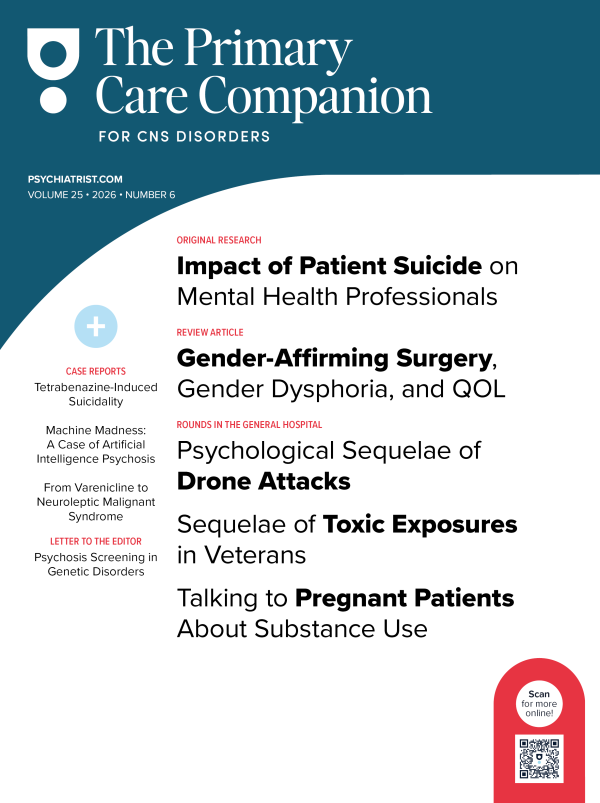Treating Symptomatic Hyperprolactinemia Secondary to a Long-Acting Injectable Atypical Antipsychotic in a Patient With Bipolar Disorder Due to an Anoxic Brain Injury
To the Editor: Atypical antipsychotic medications have become some of the most commonly prescribed medications in the United States, with 54 million prescriptions written to 3.1 million patients per year, according to recent data.1 Given the rising use of antipsychotics, the balance between the potential benefits of these medications and their possible adverse effects is of particular importance. Symptomatic hyperprolactinemia occurs in approximately 50% of women taking antipsychotics,2 and many providers are faced with the challenge of how to manage these iatrogenic symptoms while maintaining medication efficacy. We describe a case of symptomatic hyperprolactinemia in a 39-year-old woman with bipolar disorder secondary to anoxic brain injury who was treated for symptomatic hyperprolactinemia using the addition of low-dose aripiprazole to her standing regimen of long-acting injectable risperdone.
Case report. Ms A, a 39-year-old woman with bipolar disorder due to an anoxic brain injury (DSM-IV criteria), presented to her primary care physician with recurrent bilateral lactorrhea, worsening bilateral breast pain, bilateral bloody nipple discharge, and menstrual irregularities. At the time of her presentation, the patient was enjoying a 3-year period of psychiatric stability and was responding robustly to injectable, long-acting risperidone 37.5 mg intramuscularly every 2 weeks (administered in her primary care physician’s office). Prior to her trial of a long-acting injectable antipsychotic, the patient was mostly noncompliant with psychotropic medications and had experienced years of instability marked by multiple, lengthy hospitalizations and symptoms of severe mood lability, impulsivity, hypersexuality, aggression, decreased need for sleep, dangerous behaviors, social disinhibition, and cognitive deficits. Her primary care physician referred the patient to a gynecologist for further workup and contacted the patient’s psychiatry team in order to collaborate care. Laboratory results confirmed hyperprolactinemia, with a serum prolactin level of 105.94 ng/mL (non-pregnant reference range, 1.2-29.93 ng/mL). A previous magnetic resonance imaging scan of the brain did not show a structural pituitary abnormality. The patient’s serum luteinizing hormone (6.81 IU/L) and follicle-stimulating hormone (6.42 IU/L) levels were within the normal range.
Due to the patient’s stability at the time of presentation, the psychiatric treatment team sought alternatives to lowering the overall dose of long-acting injectable risperidone. A PubMed literature review (1993 to April 2013; keywords: risperidone, aripiprazole, hyperprolactinemia, symptomatic, treatment) showed evidence that aripiprazole, due to its affinity for and partial agonism at dopamine D2 receptors, decreases prolactin levels in patients with schizophrenia who were previously stabilized on treatment with an atypical antipsychotic.3 Ms A’s psychiatry team therefore added a dosage of aripiprazole 2 mg by mouth at bedtime with the goal of improving symptoms of hyperprolactinemia without destabilizing her psychiatric condition.
Over the next several weeks, Ms A’s symptoms of hyperprolactinemia improved, as she experienced minimal amounts of lactation (less than 1 mL) at 5 weeks and no lactation at 10 weeks. The patient’s breast pain completely resolved within several weeks. Five weeks after starting aripiprazole, Ms A’s prolactin level was 69.9 ng/mL (a 28.6% reduction from baseline levels). Overall, the patient experienced a remission in hyperprolactinemia symptoms and a clinically significant decrease in serum prolactin within weeks and remained psychiatrically stable without adjustment of her previous dose of long-acting injectable risperidone.
This case report is relevant to the management of patients with bipolar disorder who develop symptomatic hyperprolactinemia while taking prolactin-elevating antipsychotics. Previous studies on the efficacy of aripiprazole for lowering prolactin levels in symptomatic hyperprolactinemia pertained to a population of patients with schizophrenia3-6 and used aripiprazole doses significantly higher (15-30 mg/d)6 than those in the case of Ms A. To our knowledge, there have been no studies in bipolar patients in which aripiprazole was added to a regimen of a prolactin-elevating antipsychotic in order to reduce prolactin levels.
As a partial agonist at the dopamine D2 receptor, low-dose aripiprazole may be a viable tool for treating symptomatic, antipsychotic-induced hyperprolactinemia. The case of Ms A demonstrates that the addition of aripiprazole at doses as low as 2 mg/d can resolve hyperprolactinemia symptoms while, importantly, maintaining psychiatric stability in patients with bipolar disorder. As the number of antipsychotic prescriptions continues to escalate, due largely to the expanding scope of antipsychotic indications, providers of multiple specialties, including primary care, will be faced increasingly with the challenge of screening for and managing symptomatic hyperprolactinemia. Further study is warranted on the role aripiprazole may play in the mitigation of antipsychotic-induced hyperprolactinemia across a diverse range of patients.
References
1. Leonhauser M. Antipsychotics: multiple indications help drive growth. PM360. 2012;(Jan):22-24. http://www.pm360online.com/market-watch-antipsychotics-multiple-indications-help-drive-growth/. Updated January 1, 2012. Accessed June 25, 2013.
2. Wieck A, Haddad P. Hyperprolactinaemia caused by antipsychotic drugs. BMJ. 2002;324(7332):250-252. PubMed doi:10.1136/bmj.324.7332.250
3. Yasui-Furukori N, Furukori H, Sugawara N, et al. Dose-dependent effects of adjunctive treatment with aripiprazole on hyperprolactinemia induced by risperidone in female patients with schizophrenia. J Clin Psychopharmacol. 2010;30(5):596-599. PubMed doi:10.1097/JCP.0b013e3181ee832d
4. Chen CK, Huang YS, Ree SC, et al. Differential add-on effects of aripiprazole in resolving hyperprolactinemia induced by risperidone in comparison to benzamide antipsychotics. Prog Neuropsychopharmacol Biol Psychiatry. 2010;34(8):1495-1499. PubMed doi:10.1016/j.pnpbp.2010.08.012
5. Lee BH, Kim YK, Park SH. Using aripiprazole to resolve antipsychotic-induced symptomatic hyperprolactinemia: a pilot study. Prog Neuropsychopharmacol Biol Psychiatry. 2006;30(4):714-717. PubMed doi:10.1016/j.pnpbp.2006.02.001
6. Shim JC, Shin JG, Kelly DL, et al. Adjunctive treatment with a dopamine partial agonist, aripiprazole, for antipsychotic-induced hyperprolactinemia: a placebo-controlled trial. Am J Psychiatry. 2007;164(9):1404-1410. PubMed doi:10.1176/appi.ajp.2007.06071075
Author affiliations: Department of Psychiatry and Behavioral Sciences, Medical University of South Carolina, Charleston.
Potential conflicts of interest: None reported.
Funding/support: None reported.
Published online: September 19, 2013.
Prim Care Companion CNS Disord 2013;15(5):doi:10.4088/PCC.13l01544
© Copyright 2013 Physicians Postgraduate Press, Inc.


